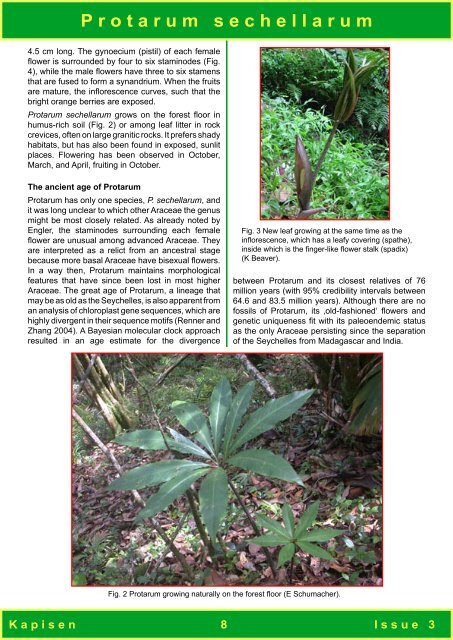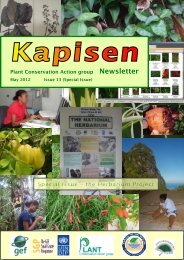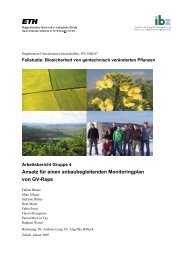Kapisen - ETH Zürich
Kapisen - ETH Zürich
Kapisen - ETH Zürich
Create successful ePaper yourself
Turn your PDF publications into a flip-book with our unique Google optimized e-Paper software.
P r o t a r u m s e c h e l l a r u m<br />
4.5 cm long. The gynoecium (pistil) of each female<br />
flower is surrounded by four to six staminodes (Fig.<br />
4), while the male flowers have three to six stamens<br />
that are fused to form a synandrium. When the fruits<br />
are mature, the inflorescence curves, such that the<br />
bright orange berries are exposed.<br />
Protarum sechellarum grows on the forest floor in<br />
humus-rich soil (Fig. 2) or among leaf litter in rock<br />
crevices, often on large granitic rocks. It prefers shady<br />
habitats, but has also been found in exposed, sunlit<br />
places. Flowering has been observed in October,<br />
March, and April, fruiting in October.<br />
The ancient age of Protarum<br />
Protarum has only one species, P. sechellarum, and<br />
it was long unclear to which other Araceae the genus<br />
might be most closely related. As already noted by<br />
Engler, the staminodes surrounding each female<br />
flower are unusual among advanced Araceae. They<br />
are interpreted as a relict from an ancestral stage<br />
because more basal Araceae have bisexual flowers.<br />
In a way then, Protarum maintains morphological<br />
features that have since been lost in most higher<br />
Araceae. The great age of Protarum, a lineage that<br />
may be as old as the Seychelles, is also apparent from<br />
an analysis of chloroplast gene sequences, which are<br />
highly divergent in their sequence motifs (Renner and<br />
Zhang 2004). A Bayesian molecular clock approach<br />
resulted in an age estimate for the divergence<br />
Fig. 3 New leaf growing at the same time as the<br />
inflorescence, which has a leafy covering (spathe),<br />
inside which is the finger-like flower stalk (spadix)<br />
(K Beaver).<br />
between Protarum and its closest relatives of 76<br />
million years (with 95% credibility intervals between<br />
64.6 and 83.5 million years). Although there are no<br />
fossils of Protarum, its ‚old-fashioned‘ flowers and<br />
genetic uniqueness fit with its paleoendemic status<br />
as the only Araceae persisting since the separation<br />
of the Seychelles from Madagascar and India.<br />
Fig. 2 Protarum growing naturally on the forest floor (E Schumacher).<br />
K a p i s e n 8 I s s u e 3







